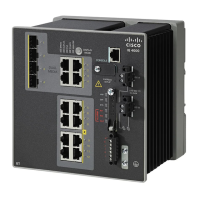2. Remove the SFP module from its protective packaging.
3. Check the markings on the SFP transceiver to verify that you have the correct model for your network.
4. Position the SFP transceiver in front of the port socket opening
Different Cisco devices have different SFP transceiver socket configurations. Your Cisco device might require
that the SFP transceiver be installed with the bale-clasp either in a latch-up or a latch-down orientation. Verify
that you have the SFP transceiver oriented correctly when you position it in front of the port socket.
Note
5. With the bale-clasp closed (locked), slide the SFP transceiver into the socket until you feel it snap in place
in the socket. You may hear an audible click as the SFP transceiver latch engages in the socket.
6. Connect the network interface cable RJ-45 plug to the SFP RJ-45 connector.
7. Observe the port status LED:
• Green indicates that the SFP transceiver and the target device established a link.
• Amber indicates that the port is discovering the network topology and searching for loops. This
process takes about 30 seconds, and then the LED turns green.
• Off indicates that the target device might not be turned on, there might be a cable problem, or there
might be a problem with the adapter installed in the target device. Refer to Troubleshooting, on page
49 for solutions to cabling problems.
Connecting to SFP Modules
This section describes how to connect to a fiber-optic or 1000BASE-T SFP port. For instructions on how to
install or remove an SFP module, see Connecting Devices to the Ethernet Ports, on page 34.
Class 1 laser product. Statement 1008
Warning
Do not connect or disconnect cables to the ports while power is applied to the switch or any device on the
network because an electrical arc can occur. This could cause an explosion in hazardous location installations.
Be sure that power is removed from the switch and cannot be accidentally be turned on, or verify that the area
is nonhazardous before proceeding. Statement 1070
Warning
Do not remove the rubber plugs from the SFP module port or the rubber caps from the fiber-optic cable until
you are ready to connect the cable. The plugs and caps protect the SFP module ports and cables from
contamination and ambient light.
Caution
To prevent ESD damage, follow standard board and component handling procedures.
Caution
Cisco IE 4010 Switch Hardware Installation Guide
31
Switch Installation
Connecting to SFP Modules

